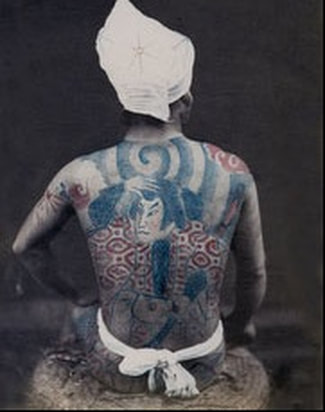2007- Clark North
The Classic Japanese Tattoo Style
(in thesis)
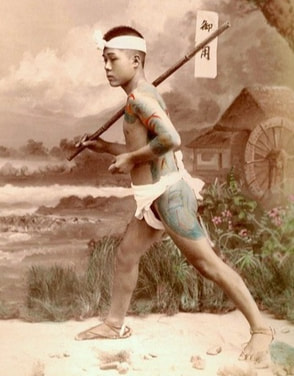 1830's - 70's Japanese tattoo. Today called- classic Japanese style, aka wabori tattoo. Photo taken aprox 1870 by
"Felice Beato"
or
"Adolfo Farsari".
1830's - 70's Japanese tattoo. Today called- classic Japanese style, aka wabori tattoo. Photo taken aprox 1870 by
"Felice Beato"
or
"Adolfo Farsari".
I
put this page together back in 2009 for those that have an interest or passion in the true classic Japanese tattoo style... a passion I have had since childhood, the mid 1970's. Many people have mentioned how helpful it has been so please give it a read, I hope you enjoy it too.
Indeed, the history of tattooing in Japan has gone through significant changes. With the westernization of Japan in the 1870s, the shogunate began to restrict tattooing on the population due to concerns that tattoos were perceived as uncivilized by Westerners. This resulted in a period from 1879 to 1948 when tattooing was illegal in Japan.
During this time, the Japanese authorities primarily targeted the tattoo artists rather than individuals with tattoos. This created a complex situation, commonly referred to as a catch-22, where getting a tattoo was not necessarily illegal, but providing tattoo services was.
However, as time passed, perceptions towards tattoos shifted, and today tattooing is more widely accepted in Japan than it has been in decades. The cultural significance of traditional Japanese tattoos, such as irezumi, has been recognized, and many people now appreciate tattoos as forms of personal expression and art.
It is a fascinating thing, the evolution of tattooing, particularly in the Western context. It’s true that the full-sized “pictorial” tattoo has its origins in Japan. However, in the late 1800s, Western tattoos underwent a transformation, becoming smaller and more affordable novelties.
The invention and refinement of the tattoo machine by Thomas Edison in the late 1800s played a significant role in making tattoos more accessible and quickly applied. Tattooers of the early 1900s started working at world fairs, traveling carnivals, circuses, and other venues, offering designs that could be applied swiftly using portable tattoo carts. These Western tattoos were designed to mimic the tattoos of the rich, well-traveled, and famous, but at a more affordable price.
As a result, smaller tattoos ranging from 1 to 5 inches in size became the norm. This trend persisted from the early 1900s until the 1970s. However, during the 1970s, tattooers like Cliff Raven, Sailor Jerry, Phil Sims, John the Dutchman, Spider Webb, Ed Hardy, and others began seeking a deeper understanding of the Japanese tattoo tradition and its origins. They traveled to Japan, studying and learning from master tattooers, which led to a resurgence and appreciation of the traditional Japanese style.
Today, we have come full circle, with a blend of Western and Japanese tattooing styles being embraced and celebrated by tattoo enthusiasts worldwide.
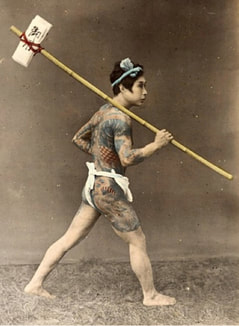 1830's - 70's Japanese tattoo. Today called- classic Japanese style, aka wabori tattoo. Photo taken aprox 1870 by
"Felice Beato"
or
"Adolfo Farsari".
1830's - 70's Japanese tattoo. Today called- classic Japanese style, aka wabori tattoo. Photo taken aprox 1870 by
"Felice Beato"
or
"Adolfo Farsari".
The un-westernized Edo style of tattooing is indeed a remarkable and enduring tradition. Originating from the late Edo period in Japan, this style has remained relatively unchanged for nearly 200 years. Japanese tattoo artists directly drew inspiration from the ukiyo-e, a popular art form of the mid-1800s, and continue to follow the same artistic style to this day.
In the Edo style, close-up vertical imagery is preferred over landscape scenery. Among the notable artists and tattooers associated with this style, Utagawa Kuniyoshi, also known as “Kuniyoshi,” stands out as the originator and most well-known artist. His work has left a significant impact and continues to inspire tattoo enthusiasts. Other renowned artists like “Kunisada,” “Ekin,” and “Kyosai” have also contributed to the rich heritage of the Edo style.
The dedication to preserving and continuing this traditional style has earned it a special place among tattoo aficionados, making it a favorite choice for many who appreciate the cultural and historical significance of Japanese tattoo art.
• Classic style -
Absolutely, in the classic style of Japanese tattooing, there is a strong emphasis on maintaining the traditional imagery and themes that were established in the 1800s. Referencing and using the classic ukiyo-e designs that were created 125-200 years ago is considered the proper way to approach classic Japanese tattooing.
Many master tattooers believe that artists like Kuniyoshi specifically designed their ukiyo-e prints to be easily adapted into tattoos. As such, preserving the original imagery without significant changes or modernizations is a key aspect of the classic style.
While the main image or imagery remains directly referenced to the original art from the mid-1800s, the backgrounding of the tattoo has evolved over time. Each tattooer brings their own unique style and personal signature to the background, resulting in variations between different artists. The backgrounding is where tattooers can showcase their individual creativity and differentiate their work while still staying true to the classic imagery.
This blend of timeless, traditional imagery and individual artistic backgrounds has been a defining characteristic of classic Japanese tattooing since its inception, allowing for a harmonious balance between tradition and personal expression.
• Be familiar with the original Edo artists -• Utagawa Kuniyoshi ~ 歌川 国芳 1797–1861
• Utagawa Kunisada ~ 歌川 国貞, also named Utagawa Toyokuni III ~ 三代歌川豊国 1786 –1865 .
• Kawanabe Kyōsai ~ 河鍋 暁斎 1831–1889.
• Baiōken Eishun ~ 梅翁軒永春, also named Hasegawa Eishun ~ 長谷川永春 1710–1755.
• Tsukioka Yoshitoshi ~ 月岡 芳年, also named Taiso Yoshitoshi ~ 大蘇 芳年 1839 –1892
• Toyohara Kunichika ~ 豊原 国周 1835 –1900 .
• Katsushika Hokusai ~ 葛飾 北斎 1760–1849.
• Utagawa Yoshitsuya ~ 歌川 芳艶 ,1822–1866, also named Kōko Yoshitsuya ~ 甲胡 芳艶and asIchieisai Yoshitsuya ~ 英斎 芳艶 .
Also check out:
• Hirose Kinzo (Ekin) • Utagawa Yoshifuji • Soga Shohaku • Yoshikazu • Hokui • Toyokuni I • Iijima Koga • Kunitora • Shunei • Shuntei • Utamaro • Watanabe Kazan • Kunimaru • Chikanobu • Yoshiiku • Oniwaka-maru • Yoshitora • Hokui • Shunsho II.
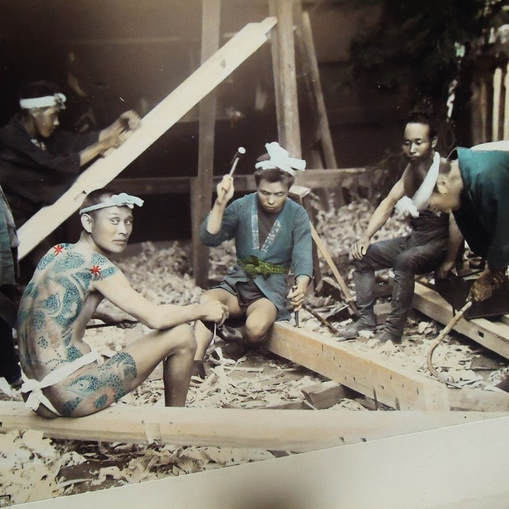 1830's - 70's Japanese tattoo. Today called- classic Japanese style, aka wabori tattoo. Photo taken aprox 1870 by
"Felice Beato"
or
"Adolfo Farsari".
1830's - 70's Japanese tattoo. Today called- classic Japanese style, aka wabori tattoo. Photo taken aprox 1870 by
"Felice Beato"
or
"Adolfo Farsari".
•WHO was wearing horimono during Edo era Japan?:
The question of who wore tattoos in Japan during the 1800s has sparked various opinions and debates among historians. Different sources provide different perspectives, leading to multiple theories about the demographics of tattooed individuals during that time. It’s important to note that the following points reflect these different viewpoints:
• Some argue that it was primarily the lower working classes, who wanted to enhance their attractiveness and appeal to their peers, friends, and romantic partners.
• Others suggest that it was predominantly the firemen and dock workers who wore tattoos.
• There are claims that only the wealthy individuals, who were prohibited by law from flaunting their wealth, opted for expensive hidden tattoos under their clothing.
• Some propose that it was limited to gambling house workers and their overseers.
• And yet another perspective asserts that it was mainly criminals who wore tattoos to cover their punishment marks and conceal their past.
It is worth noting that there were indeed different types of patrons who sought tattoos during the late Edo period (1830-1870). It was a time when being heavily tattooed with full-sized Japanese imagery was quite common and popular, particularly in the Edo area of Japan. Estimates suggest that anywhere from 20,000 to 100,000 individual Japanese people per decade received such tattoos.
Considering the multitude of opinions and varying historical accounts, it can be intriguing and even amusing to explore the different theories surrounding tattooed individuals in Japan during the 1800s.
During the late 1820s to the 1890s, the most common age range for acquiring a tattoo in Japan was between 12 to 30 years old. The completion of a tattoo could take anywhere from 1 to 10 years, depending on the extent of skin coverage and how frequently the patron visited the tattoo artist (horishi).
This period spanning 70 years was not a passing fad in Japan; it was a normal and integral part of Japanese society. Tattooing held significant cultural and heritage value, much like it did in many American Indian tribes or various Pacific island cultures. Being tattooed was considered a customary aspect of life until the late 1800s when the influences of so-called civilization and westernization began to shape the modern world.
The strong connection between tattooing and Japanese heritage and culture highlights its enduring significance and the role it played in the lives of many individuals during that era.
The question of who wore tattoos in Japan during the 1800s has sparked various opinions and debates among historians. Different sources provide different perspectives, leading to multiple theories about the demographics of tattooed individuals during that time. It’s important to note that the following points reflect these different viewpoints:
• Some argue that it was primarily the lower working classes, who wanted to enhance their attractiveness and appeal to their peers, friends, and romantic partners.
• Others suggest that it was predominantly the firemen and dock workers who wore tattoos.
• There are claims that only the wealthy individuals, who were prohibited by law from flaunting their wealth, opted for expensive hidden tattoos under their clothing.
• Some propose that it was limited to gambling house workers and their overseers.
• And yet another perspective asserts that it was mainly criminals who wore tattoos to cover their punishment marks and conceal their past.
It is worth noting that there were indeed different types of patrons who sought tattoos during the late Edo period (1830-1870). It was a time when being heavily tattooed with full-sized Japanese imagery was quite common and popular, particularly in the Edo area of Japan. Estimates suggest that anywhere from 20,000 to 100,000 individual Japanese people per decade received such tattoos.
Considering the multitude of opinions and varying historical accounts, it can be intriguing and even amusing to explore the different theories surrounding tattooed individuals in Japan during the 1800s.
During the late 1820s to the 1890s, the most common age range for acquiring a tattoo in Japan was between 12 to 30 years old. The completion of a tattoo could take anywhere from 1 to 10 years, depending on the extent of skin coverage and how frequently the patron visited the tattoo artist (horishi).
This period spanning 70 years was not a passing fad in Japan; it was a normal and integral part of Japanese society. Tattooing held significant cultural and heritage value, much like it did in many American Indian tribes or various Pacific island cultures. Being tattooed was considered a customary aspect of life until the late 1800s when the influences of so-called civilization and westernization began to shape the modern world.
The strong connection between tattooing and Japanese heritage and culture highlights its enduring significance and the role it played in the lives of many individuals during that era.
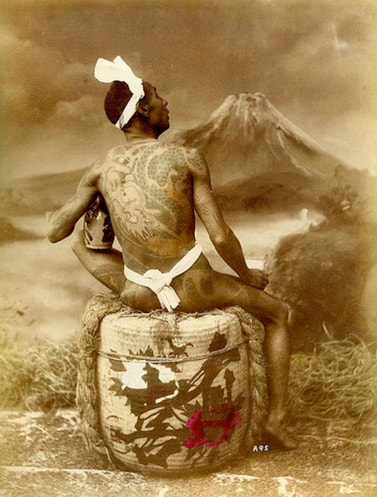
During the end of the 19th century (late 1800's) Japanese tattooing was very popular with world travelers - it became a fad of the western political uppers, the rich & the royal to be tattoo'd by Edo tattoo masters, it was all the rage for 30 or 40 years.
Some examples of the well known westerners that sought Japanese tattooing back in the day were England's “Duke of York” (whom later became King George V). King George V had a large dragon tattooed on his fore-arm by “Horicho”. Also his brother the Duke of Clarence was heavily tattooed. The Duke of York & the Duke of Clarence commissioned the tattoo master Horicho to Europe and New England, first on the two year venture in England, later to the America's New England area, this led to a one and a half year commission for his high clout & political friends, a networking, friendship & good-will gift. “Horicho” also tattooed "the Czarevitch of Russia” ... Here is a handful of others - there were "Nicolas II", "Frederick VIII" of Denmark, "Duke Alfred" of Edinburgh and Coburg, "Queen Olga" of Greece, and "the princesses de Leon and Sagan"... that’s just to name a few! Many Japanese tattooers advertised in European travel guides, books and brochures so that they would be found by the westerners.
Some examples of the well known westerners that sought Japanese tattooing back in the day were England's “Duke of York” (whom later became King George V). King George V had a large dragon tattooed on his fore-arm by “Horicho”. Also his brother the Duke of Clarence was heavily tattooed. The Duke of York & the Duke of Clarence commissioned the tattoo master Horicho to Europe and New England, first on the two year venture in England, later to the America's New England area, this led to a one and a half year commission for his high clout & political friends, a networking, friendship & good-will gift. “Horicho” also tattooed "the Czarevitch of Russia” ... Here is a handful of others - there were "Nicolas II", "Frederick VIII" of Denmark, "Duke Alfred" of Edinburgh and Coburg, "Queen Olga" of Greece, and "the princesses de Leon and Sagan"... that’s just to name a few! Many Japanese tattooers advertised in European travel guides, books and brochures so that they would be found by the westerners.
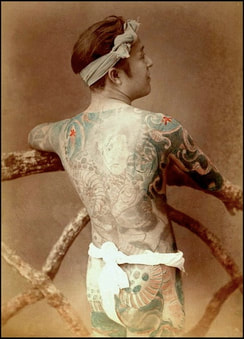
• WEARING THE "CLASSIC" JAPANESE TATTOO:
When it comes to wearing the classic Japanese style... it's a nostalgia for the Japanese art & life of the late Edo period. The art as well the attitude... That's the whole thing in a nutshell.
• Classic Japanese tattooing is classic folklore, chivalry, heroism and or mythology tattooed at a full enough size to fit the body like a robe. Referencing the original artwork and tattooing it in its original style.
Also - when someone is wearing "classic" Japanese style tattoo, it is something that they have very much dedicated themselves to. Some people put a lot of time & money into into it just the same as some people put a lot of time & money into perhaps... fancy cars, watches, or even a dream kitchen or a necklace, etc...
• Shared Pride:
It can be surprising - the dedication, pain, cost and patience that it takes to get this style of tattoo. In my experience the people that wear horimono are usually hard working quiet types people that don't look like they would have any tattoos at all. It may surprise you that the dean at your college, surgeon or family doctor or even a judge at the courthouse may be a true collectors of this style tattoo - all of which I have heavily tattooed. Horimono collectors tend to have a depth in doing things that others don't. With a quiet, content self-pride as well as strong self discipline, I greatly admire my clients for just that as this style takes a lot of time, self control, time management and dedication..
• Clark is here for you once you have already decided on this, not to teach you or help you decide. Wearing full sized Edo era style tattooing is a very personal choice.
• Difference Between Western and Classic Japanese Style Tattooing:
Classic Edo era style tattoo isn't applied randomly, it's not a gathering of collectable badges as in graffiti or trophy tattooing. Also the classic Japanese tattoo is not done with modern realism, it has the unchanged style of the 1800's. Classic style tattooers are not trying to come up with new ideas. There are no competitive artists trying to find the next quick selling idea or gimmick. Creating new things is simply not the classic style. Yes each patrons tattoo is designed for each individual... and each does have individual intent, just as in all forms of art. Yet what is referenced is the Edo era art from the 1800's... Aspiration, dreams, hopes, un-wanted weaknesses, fears, strengths wanted possessed or desired are in the art. Anywhere from ankle to neck - it is the passion and admiration for the Edo period art, story and style... a passion for the "artwork" that existed during 1830's to the 1870's.
When it comes to wearing the classic Japanese style... it's a nostalgia for the Japanese art & life of the late Edo period. The art as well the attitude... That's the whole thing in a nutshell.
• Classic Japanese tattooing is classic folklore, chivalry, heroism and or mythology tattooed at a full enough size to fit the body like a robe. Referencing the original artwork and tattooing it in its original style.
Also - when someone is wearing "classic" Japanese style tattoo, it is something that they have very much dedicated themselves to. Some people put a lot of time & money into into it just the same as some people put a lot of time & money into perhaps... fancy cars, watches, or even a dream kitchen or a necklace, etc...
• Shared Pride:
It can be surprising - the dedication, pain, cost and patience that it takes to get this style of tattoo. In my experience the people that wear horimono are usually hard working quiet types people that don't look like they would have any tattoos at all. It may surprise you that the dean at your college, surgeon or family doctor or even a judge at the courthouse may be a true collectors of this style tattoo - all of which I have heavily tattooed. Horimono collectors tend to have a depth in doing things that others don't. With a quiet, content self-pride as well as strong self discipline, I greatly admire my clients for just that as this style takes a lot of time, self control, time management and dedication..
• Clark is here for you once you have already decided on this, not to teach you or help you decide. Wearing full sized Edo era style tattooing is a very personal choice.
• Difference Between Western and Classic Japanese Style Tattooing:
Classic Edo era style tattoo isn't applied randomly, it's not a gathering of collectable badges as in graffiti or trophy tattooing. Also the classic Japanese tattoo is not done with modern realism, it has the unchanged style of the 1800's. Classic style tattooers are not trying to come up with new ideas. There are no competitive artists trying to find the next quick selling idea or gimmick. Creating new things is simply not the classic style. Yes each patrons tattoo is designed for each individual... and each does have individual intent, just as in all forms of art. Yet what is referenced is the Edo era art from the 1800's... Aspiration, dreams, hopes, un-wanted weaknesses, fears, strengths wanted possessed or desired are in the art. Anywhere from ankle to neck - it is the passion and admiration for the Edo period art, story and style... a passion for the "artwork" that existed during 1830's to the 1870's.
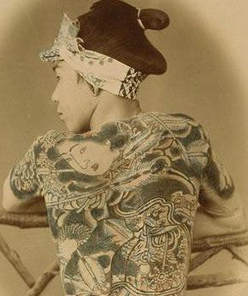 1830's - 70's Japanese tattoo. Today called- classic Japanese style, aka wabori tattoo. Photo taken aprox 1870 by
"Felice Beato"
or
"Adolfo Farsari".
1830's - 70's Japanese tattoo. Today called- classic Japanese style, aka wabori tattoo. Photo taken aprox 1870 by
"Felice Beato"
or
"Adolfo Farsari".
• The traditional Japanese tattoo is basically the same now as it was 200 years ago - To do another style or use un-related themes, or even to shrink images down to fit small parts of the body - is simply doing something different... i.e. If the tattoo is being done realistically it's not traditional or classic. If the tattoo is being done in anime style it's not traditional. If the tattoo is being shrunk down to fit more things into one spot it's not classic. This is NOT saying that the other styles suck, it's not saying anything like that. Only saying that there are differences between styles... Simply explaining what is and what is not classic Japanese tattoo style. The classic tattoo is not modernized or westernized, it is as it has been for more than 200 years.
• Chinese, Tibetan, Hindu artwork etc... they all contain great imagery, style, story, folklore and designs- yet they are all quite different from Classic Japanese style tattooing. They are not what i specialize in - That would kind of be like saying that all Asians are the same... and to say that is rude.
• Chinese, Tibetan, Hindu artwork etc... they all contain great imagery, style, story, folklore and designs- yet they are all quite different from Classic Japanese style tattooing. They are not what i specialize in - That would kind of be like saying that all Asians are the same... and to say that is rude.
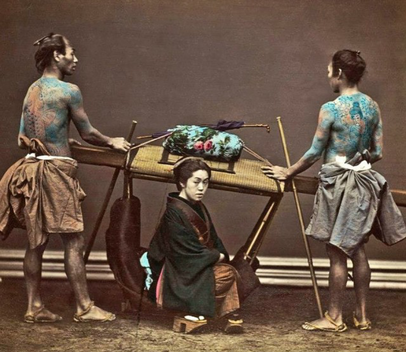 1830's - 70's Japanese tattoo. Today called- classic Japanese style, aka wabori tattoo. Photo taken aprox 1870 by
"Felice Beato"
or
"Adolfo Farsari".
1830's - 70's Japanese tattoo. Today called- classic Japanese style, aka wabori tattoo. Photo taken aprox 1870 by
"Felice Beato"
or
"Adolfo Farsari".
• Genre (some of the tattoo themes) of classic horimono:
To absorb the strengths of the imagery that you wear as tattoo is the traditional way, meaning what you wear is your personal goal (lightheartedly).
The client usually has a "theme" or "genre" in mind, then the framing imagery and backgrounding is done by the tattooer according to what is being done. From the client what is most important from the beginning is to know "how much coverage" is wanted and what "theme / genre" that is wanted. If you do not want a back-tattoo done in the beginning it is OK, but it is best to know, because when a full suit is decided later it can have adverse effects on the tattoo on a whole. Adding things later can look awkward.
• -Folk story ~Crain, ghostly temple, Heiki bay etc. if these are your favorite type of stories then this is your tattoo theme.
• -Hero with Heavenly animal / vigilante / ronin / warrior with “... ~if you love the warrior and hero stories including fantasy then this is the tattoo theme for you, plus if you like the fantasy of heavenly animals, if that is your thing then they fit in with and frame the hero theme greatly.
• -Hero with Floral earth / vigilante / ronin / warrior ... ~if you like the true stories, the stories more along the lines of "history" rather than fantasy; then using the earth animals and or the "floating world" enhancement and framing is proper for you.
• -Heavenly deities ~Fudo Myo, Fujin & Raijin etc.
• -Heavenly goddess ~Benten/Benzaiten, Tennyo etc.
• -Battling hell and hell creatures ~ hells punishments, night parade of one hundred demons.
• -Religious ~ Fudo, Buddha, Daruma etc. This tattooing style includes lotus. the lotus is a religious symbol.
• -Bijin / Bijinga ~ Beautiful woman art.
• -Forest and village folk story: magic, dangerous beings and animals ~Chinnon, witches, water Kappa, forest Tengu, giant boar, giant bear, monster fish etc.
• -Heavenly animals ~Koi, Fu Lion, Phoenix, Dragon etc.
• -Earthly animals ~Koi, hawk, rabbit, toad, frog, rat, snake etc... most often used with religious themes.
• -Ghost story ~if your favorite stories are the "ghost stories" of Japan this tattoo is for you, it is done not by only imaging one story, but an overall of the genre.
• -Yokai ~Monsters and spirits.
• -Noh Plays theme / classic Japanese theater (if you love the classic Noh theater, then this is your tattoo theme. This tattoo theme is done by using the theater drama masks from the Noh plays, when you see someone with these masks tattooed on them it is showing their passion for this very respected classic form of drama... example masks of Hannya, Kawagoe, Hyottoko, Tengu and the Tengu King, oni, Enma etc... Generally you can tell that these are the masks rather than incarnate; you will see the ropes attached.
• -Shunga ~erotic art.
To absorb the strengths of the imagery that you wear as tattoo is the traditional way, meaning what you wear is your personal goal (lightheartedly).
The client usually has a "theme" or "genre" in mind, then the framing imagery and backgrounding is done by the tattooer according to what is being done. From the client what is most important from the beginning is to know "how much coverage" is wanted and what "theme / genre" that is wanted. If you do not want a back-tattoo done in the beginning it is OK, but it is best to know, because when a full suit is decided later it can have adverse effects on the tattoo on a whole. Adding things later can look awkward.
• -Folk story ~Crain, ghostly temple, Heiki bay etc. if these are your favorite type of stories then this is your tattoo theme.
• -Hero with Heavenly animal / vigilante / ronin / warrior with “... ~if you love the warrior and hero stories including fantasy then this is the tattoo theme for you, plus if you like the fantasy of heavenly animals, if that is your thing then they fit in with and frame the hero theme greatly.
• -Hero with Floral earth / vigilante / ronin / warrior ... ~if you like the true stories, the stories more along the lines of "history" rather than fantasy; then using the earth animals and or the "floating world" enhancement and framing is proper for you.
• -Heavenly deities ~Fudo Myo, Fujin & Raijin etc.
• -Heavenly goddess ~Benten/Benzaiten, Tennyo etc.
• -Battling hell and hell creatures ~ hells punishments, night parade of one hundred demons.
• -Religious ~ Fudo, Buddha, Daruma etc. This tattooing style includes lotus. the lotus is a religious symbol.
• -Bijin / Bijinga ~ Beautiful woman art.
• -Forest and village folk story: magic, dangerous beings and animals ~Chinnon, witches, water Kappa, forest Tengu, giant boar, giant bear, monster fish etc.
• -Heavenly animals ~Koi, Fu Lion, Phoenix, Dragon etc.
• -Earthly animals ~Koi, hawk, rabbit, toad, frog, rat, snake etc... most often used with religious themes.
• -Ghost story ~if your favorite stories are the "ghost stories" of Japan this tattoo is for you, it is done not by only imaging one story, but an overall of the genre.
• -Yokai ~Monsters and spirits.
• -Noh Plays theme / classic Japanese theater (if you love the classic Noh theater, then this is your tattoo theme. This tattoo theme is done by using the theater drama masks from the Noh plays, when you see someone with these masks tattooed on them it is showing their passion for this very respected classic form of drama... example masks of Hannya, Kawagoe, Hyottoko, Tengu and the Tengu King, oni, Enma etc... Generally you can tell that these are the masks rather than incarnate; you will see the ropes attached.
• -Shunga ~erotic art.
|
One of the most noticeable differences between western and Japanese tattoo is the size of the imagery. The Japanese tattoo is one overall image or theme fitted proportionately on the entire body like a carving. Full coverage in western tattooing is done by applying hand sized souvenir tattoos until the amount of coverage is achieved. Its a bit like filling a wall shelf with knick-knack’s. Also in western style tattooing- designs do not have any need to match ideals or have anything to do with other tattoos on the same body... in western tattooing the meanings, themes, ideologies or even the styles can be randomly placed right next to each other. The Japanese tattoo is not random like this, and because of this- the Japanese tattoo is not easily executed, understood or designed. It takes an experienced craftsman with many years of study to master it.
|
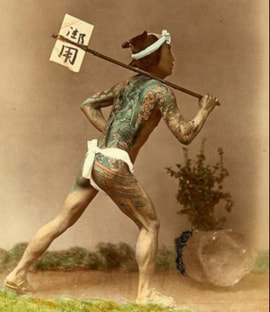 1830's - 70's Japanese tattoo. Today called- classic Japanese style, aka wabori tattoo. Photo taken aprox 1870 by
"Felice Beato"
or
"Adolfo Farsari".
1830's - 70's Japanese tattoo. Today called- classic Japanese style, aka wabori tattoo. Photo taken aprox 1870 by
"Felice Beato"
or
"Adolfo Farsari".
A great example between western and Japanese tattooing is- if you were to walk into an art gallery and see 20 or 30 paintings, then get them all randomly tattooed on you, this represents western style tattooing. In Japanese style- you pick only one... giving your skin as the one canvas.
In the traditional Japanese world- the tattoo is very personal and it is shown only on special occasions. They say to show ones tattoo too much may bring bad luck.
The Passion is the art... designs are referenced (most often) from the existing art of 1830's to 1870's Edo period artists. These artists were creating imagery based on classic stories, and the modern day wabori style tattooer does the same. Embracing the un-blended bold coloring and basic line use... fitting the tattoo on the body like clothing... It is "carrying on" an old style that has been around since way before this most recent tattoo popularity.
Just as in all forms of tattoo, horimono has a great history, there are particulars from one tattoo family to another, but each area of horimono have all this one thing, this one nexus in common, it is the tattoo from the artists of 1830's to 1870's Edo Japan- during which- being heavily tattooed was quite normal everyday life.
Many of the wood block prints from this period were designed as tattoo designs as well; they were designed as tattoo reference and ideas "flash" by artists such as Kunisada. Kuniyoshi and Kyosai, who were top artists of their day as well, were tattooers as well as artists and the artists were tattooed themselves... from the 1830's-on, the defining moment that the tattoo changed from graphic markings to artistic pictoral imagery.
In the traditional Japanese world- the tattoo is very personal and it is shown only on special occasions. They say to show ones tattoo too much may bring bad luck.
The Passion is the art... designs are referenced (most often) from the existing art of 1830's to 1870's Edo period artists. These artists were creating imagery based on classic stories, and the modern day wabori style tattooer does the same. Embracing the un-blended bold coloring and basic line use... fitting the tattoo on the body like clothing... It is "carrying on" an old style that has been around since way before this most recent tattoo popularity.
Just as in all forms of tattoo, horimono has a great history, there are particulars from one tattoo family to another, but each area of horimono have all this one thing, this one nexus in common, it is the tattoo from the artists of 1830's to 1870's Edo Japan- during which- being heavily tattooed was quite normal everyday life.
Many of the wood block prints from this period were designed as tattoo designs as well; they were designed as tattoo reference and ideas "flash" by artists such as Kunisada. Kuniyoshi and Kyosai, who were top artists of their day as well, were tattooers as well as artists and the artists were tattooed themselves... from the 1830's-on, the defining moment that the tattoo changed from graphic markings to artistic pictoral imagery.
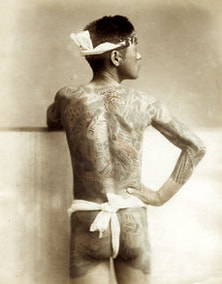
• Recommended art to view...
"Some" original Edo period "UKIYO E" series to seek:
-108 Heroes Of The Suikoden (Kuniyoshi 1827-30).
-800 Heroes Of Our Country's Suikoden. (1830).
-Hyaku Monogatari. (1830).
-Pictures Of The 8 Trigrams In Chinese Divination. (1835).
-Birds And Beasts (Kuniyoshi 1837).
-8 Dog History of Old Kyokutei. (1842).
-108 Heroes Of The Suikoden -1845 (Re-draws of Kuniyoshi's previous).
-100 Generals Brave In Battle At Kawanakajima. (1845).
-Men Of Ready Money With True Labels Attached: Kuniyoshi Fashion. (1845).
-Chronicles Of Japanese And Chinese Heroes. (1847-48).
-Lives Of Japanese Heroes. (1847-50).
-10 Famous Excellencies Of Tametomo. (Kuniyoshi 1848).
-Courageous Generals Of Kai And Echigo Provinces: The 24 Generals of the Takeda Clan. (1848).
-Famous Views Of Edo For The 12 Months. (1852).
-69 Stations Of The Kiskaido Road. (1852).
-8 Views Of Military Brilliance. (1852).
-12 Zodiac Signs And 12 Japanese Heroes. (Kuniyoshi 1854).
-108 Heroes Of The Suikoden, One By One. (1855).
-800 Japanese Suikoden Heros. (1855).
-Mirror Of Warriors Of Our Country. (Kuniyoshi 1855).
-Japanese And Chinese Comparisons For The Chapters Of Genji. (1855).
-Honcho Musha Kagami. (1856).
-Heroes Matched to 5 Colors. (1857).
-Tametomo nomare no jukketsu. (Ten Excellencies Of Tametomo). (1858).
-Analogies For The Six Conditions Of Nature. (Kuniyoshi 1860).
-Modern Rogues With Morning Glory. (1860).
-100 Pictures by Kyosai. (1862).
-Toyokuni kigo kijutsu kurabe. (1864).
-Fuzoku choju zufu. (1869-70).
-Kyosai Rakuga. (1874).
-Japanese Brocades From The Genroku period. (1886).
-Chimei junikagestsu no uchi (collaboration with Kunichika) (1882).
-Drunk Pictures By Kyosai. (1882-84).
-100 monsters. (Kyosai 1889).
-100 Ghosts. (1890).
-Peoples History Of The Suikoden. (18??).
-Military Brilliance Of The Eight Views. (18??).
-Mirror Of Excellence And Fierce Courage. (18??).
-A Suikoden Of Japanese Heroes. (18??).
-Heroes Of The Popular History Of The 3 Kingdoms. (18??).
-Genpei War Chronicles. (18??).
-100 Stories Of Military Valour. (18??).
...There are many more and perhaps you will find a favorite and grow a passion for this very stylized form of art as I have.
"Some" original Edo period "UKIYO E" series to seek:
-108 Heroes Of The Suikoden (Kuniyoshi 1827-30).
-800 Heroes Of Our Country's Suikoden. (1830).
-Hyaku Monogatari. (1830).
-Pictures Of The 8 Trigrams In Chinese Divination. (1835).
-Birds And Beasts (Kuniyoshi 1837).
-8 Dog History of Old Kyokutei. (1842).
-108 Heroes Of The Suikoden -1845 (Re-draws of Kuniyoshi's previous).
-100 Generals Brave In Battle At Kawanakajima. (1845).
-Men Of Ready Money With True Labels Attached: Kuniyoshi Fashion. (1845).
-Chronicles Of Japanese And Chinese Heroes. (1847-48).
-Lives Of Japanese Heroes. (1847-50).
-10 Famous Excellencies Of Tametomo. (Kuniyoshi 1848).
-Courageous Generals Of Kai And Echigo Provinces: The 24 Generals of the Takeda Clan. (1848).
-Famous Views Of Edo For The 12 Months. (1852).
-69 Stations Of The Kiskaido Road. (1852).
-8 Views Of Military Brilliance. (1852).
-12 Zodiac Signs And 12 Japanese Heroes. (Kuniyoshi 1854).
-108 Heroes Of The Suikoden, One By One. (1855).
-800 Japanese Suikoden Heros. (1855).
-Mirror Of Warriors Of Our Country. (Kuniyoshi 1855).
-Japanese And Chinese Comparisons For The Chapters Of Genji. (1855).
-Honcho Musha Kagami. (1856).
-Heroes Matched to 5 Colors. (1857).
-Tametomo nomare no jukketsu. (Ten Excellencies Of Tametomo). (1858).
-Analogies For The Six Conditions Of Nature. (Kuniyoshi 1860).
-Modern Rogues With Morning Glory. (1860).
-100 Pictures by Kyosai. (1862).
-Toyokuni kigo kijutsu kurabe. (1864).
-Fuzoku choju zufu. (1869-70).
-Kyosai Rakuga. (1874).
-Japanese Brocades From The Genroku period. (1886).
-Chimei junikagestsu no uchi (collaboration with Kunichika) (1882).
-Drunk Pictures By Kyosai. (1882-84).
-100 monsters. (Kyosai 1889).
-100 Ghosts. (1890).
-Peoples History Of The Suikoden. (18??).
-Military Brilliance Of The Eight Views. (18??).
-Mirror Of Excellence And Fierce Courage. (18??).
-A Suikoden Of Japanese Heroes. (18??).
-Heroes Of The Popular History Of The 3 Kingdoms. (18??).
-Genpei War Chronicles. (18??).
-100 Stories Of Military Valour. (18??).
...There are many more and perhaps you will find a favorite and grow a passion for this very stylized form of art as I have.
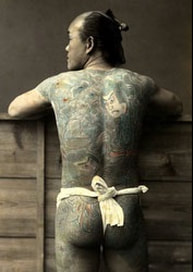
Todays Japanese tattoo masters still do tattooing in the classic style, the wabori tattoo. Horikyo is my personal favorite modern day tattooer. It is very enjoyable for me to view his works because he has such a strong connection to the past.
- Full sized classic Edo period stylized tattoo - "WABORI TATTOOERS":
~ Hori Kyo
~ Kaname Ozuma
~ Hori Toshi 1
~ Hori Ren1
Also "HERE" is a great & informative youtube video, a short seminar given on the subject.
- Full sized classic Edo period stylized tattoo - "WABORI TATTOOERS":
~ Hori Kyo
~ Kaname Ozuma
~ Hori Toshi 1
~ Hori Ren1
Also "HERE" is a great & informative youtube video, a short seminar given on the subject.
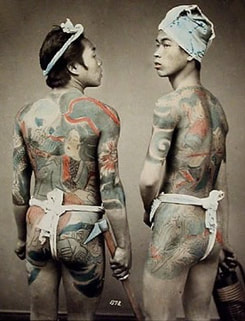
• When is message and meaning found in the classic tattoo?:
Horimono is mostly worn as a decoration (decoration of ones temple), it is sometimes worn and viewed as story telling, but most often it is simply decorative just as framed art on a wall, or the doors of a great house or temple... but when it is applied as story telling it is done as "private aspirations" rather than "public messages", horimono is not a souvenir or trophy, it is thought of as humble and personal rather than loud and possibly crass.
Exact over all story can be done, it does take a great knowledge of each particular story to do it and it is followed throughout the entire suit. When story is wanted it is to personally aspire to the imagery, goals of now and the future rather than memories or moments of the past, having "an overall understanding" of life's path.
Horimono is mostly worn as a decoration (decoration of ones temple), it is sometimes worn and viewed as story telling, but most often it is simply decorative just as framed art on a wall, or the doors of a great house or temple... but when it is applied as story telling it is done as "private aspirations" rather than "public messages", horimono is not a souvenir or trophy, it is thought of as humble and personal rather than loud and possibly crass.
Exact over all story can be done, it does take a great knowledge of each particular story to do it and it is followed throughout the entire suit. When story is wanted it is to personally aspire to the imagery, goals of now and the future rather than memories or moments of the past, having "an overall understanding" of life's path.
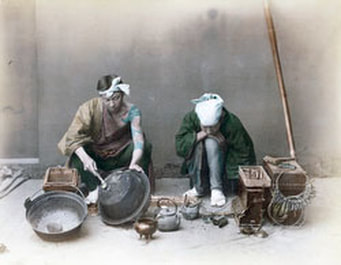
... Consider the human body as a vertical canvas; it does not have a horizontal flow.
The LEAST useful imagery in horimono are "landscapes" (for example) by such artists as Hiroshige, because these are far away un-detailed horizontal views, these do not flow well with the body as they oppose its vertical shape. these are not nicely ornate with classic cascading, floral or sumi background. If what you want is "true classic style" horimono- landscapes are best left as wall art. The imagery used for classic tattoo is more “close-up” and easily fitted to the vertical framework of the human body parts. Small “sized down” imagery is not traditional... for example; a warrior, ronin, vigilante or oni- have their faces not smaller than 3 or 4 inches from brow to chin, sizing them smaller simply is not standard wabori.
The LEAST useful imagery in horimono are "landscapes" (for example) by such artists as Hiroshige, because these are far away un-detailed horizontal views, these do not flow well with the body as they oppose its vertical shape. these are not nicely ornate with classic cascading, floral or sumi background. If what you want is "true classic style" horimono- landscapes are best left as wall art. The imagery used for classic tattoo is more “close-up” and easily fitted to the vertical framework of the human body parts. Small “sized down” imagery is not traditional... for example; a warrior, ronin, vigilante or oni- have their faces not smaller than 3 or 4 inches from brow to chin, sizing them smaller simply is not standard wabori.
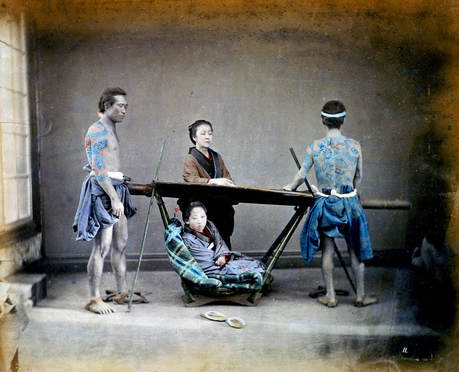
• "Ukiyo e" / “Posters”:
Edo period "Ukiyo e" (wood block prints) were affordable posters -sized at about 7 fists high and 4 fists wide, printed via carved wood. It's said that most every house in Edo Japan collected them as affordable and fun folk art, placed on walls or carefully stowed in a drawer for occasional viewing, game playing and or story telling. They didn't have TV or the Internet; these posters were the visual entertainment of the day. The stylized art on Edo period ukiyo e is very strong and simplistic, it is and always has been very tattoo oriented and it can be very enjoyable to the eye. Duplication of the Edo wood block print images and their style (with black outlines and strong fields of Sparingly placed color) makes very long lasting tattoos that are easily read and not easily destroyed by the blurring and softening that occurs in the skin with age. Many of the wood block prints from that time were specifically designed to be used directly as tattoos, this is evident in the many images done with an upside down "Y" shape in order for the main image to be used on the back -where the lower half of the tattoo needs to extend on to each thigh and taking the butt-crack into account. It's been told to me several times by Japanese tattooers and their patrons that Kuniyoshi and Kyosai themselves were tattooers as well as working artists. They were heavily tattooed and loved tattooing and they often designed ukiyo e that could be used for tattoo by other tattooers. They say that these artists being heavily tattooed (and tattooers as well) is not included in many art books because of the snobbery by some modern day art collectors -they feel mentioning this fact may de-value their collections and thus lower the value of the antique ukiyo e (and other privately owned collected arts by them). Though this stylized art was not limited to ukiyo e, the affordability of ukiyo e is the reason that so many working-class people obtained the imagery, the rich & elite did have commissioned, custom art that is classically stylized the same because the rich mans art was painted and executed by the exact same artists that designed the ukiyo e (rich mans art is generally room dividers, ceiling art, furniture, painted walls etc...), yet the easiest place to find this art style by the masses was ukiyo e, before ukiyo e only the wealthy were able to have, afford and or view skilled art.
Edo period "Ukiyo e" (wood block prints) were affordable posters -sized at about 7 fists high and 4 fists wide, printed via carved wood. It's said that most every house in Edo Japan collected them as affordable and fun folk art, placed on walls or carefully stowed in a drawer for occasional viewing, game playing and or story telling. They didn't have TV or the Internet; these posters were the visual entertainment of the day. The stylized art on Edo period ukiyo e is very strong and simplistic, it is and always has been very tattoo oriented and it can be very enjoyable to the eye. Duplication of the Edo wood block print images and their style (with black outlines and strong fields of Sparingly placed color) makes very long lasting tattoos that are easily read and not easily destroyed by the blurring and softening that occurs in the skin with age. Many of the wood block prints from that time were specifically designed to be used directly as tattoos, this is evident in the many images done with an upside down "Y" shape in order for the main image to be used on the back -where the lower half of the tattoo needs to extend on to each thigh and taking the butt-crack into account. It's been told to me several times by Japanese tattooers and their patrons that Kuniyoshi and Kyosai themselves were tattooers as well as working artists. They were heavily tattooed and loved tattooing and they often designed ukiyo e that could be used for tattoo by other tattooers. They say that these artists being heavily tattooed (and tattooers as well) is not included in many art books because of the snobbery by some modern day art collectors -they feel mentioning this fact may de-value their collections and thus lower the value of the antique ukiyo e (and other privately owned collected arts by them). Though this stylized art was not limited to ukiyo e, the affordability of ukiyo e is the reason that so many working-class people obtained the imagery, the rich & elite did have commissioned, custom art that is classically stylized the same because the rich mans art was painted and executed by the exact same artists that designed the ukiyo e (rich mans art is generally room dividers, ceiling art, furniture, painted walls etc...), yet the easiest place to find this art style by the masses was ukiyo e, before ukiyo e only the wealthy were able to have, afford and or view skilled art.
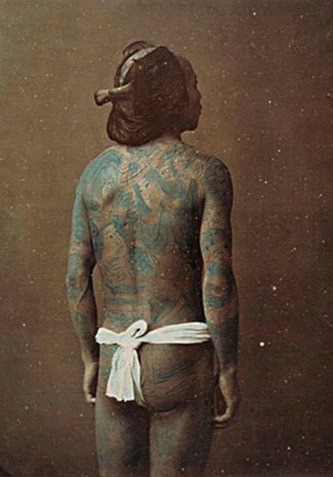
• Back-grounding:
... When the imagery is backgrounded- it is traditionally backgrounded and framed with wind, earth and water, in these there is floral representing "the Floating World" (in Edo Japan “early Tokyo”; to say "in the Floating World" is the same as saying "in Edo Japan"). When strong and mighty imagery such as Dragon or Tiger are tattooed -then generally fire and or lightning is used instead of, or as well as floral. The floral is "floating" in a field of black and grey wind, water and earth to give all the sparingly placed color a “strong look” with out being overwhelmed. Floating the imagery also classically connects the tattoo with the traditional STYLE of "the Floating World". The arms are not traditionally tattooed with strong main theme imagery (WHEN THEY ARE PART OF AN ENTIRE SUIT). Arms are tattooed to frame, accent and enhance the main image on the back, so when the torso is tattooed there should not be more powerful imagery on the arm (unless the back is never to be tattooed), the back "traditionally" should not be upstaged as it IS the place for the main imagery. If the arms and or legs overwhelm the back then there is miss-balance in the tattoo (a simple example to help you understand this.... lets say if there is something like a serpent, dragon or a fu-lion etc... something along those lines on the back, then (for example) to put a great and strong warrior, or heavenly goddess on the arm would be strange... well frankly this would not make good "true classic" tattooing, there is classically a balance of imagery throughout one persons suit.
... When the imagery is backgrounded- it is traditionally backgrounded and framed with wind, earth and water, in these there is floral representing "the Floating World" (in Edo Japan “early Tokyo”; to say "in the Floating World" is the same as saying "in Edo Japan"). When strong and mighty imagery such as Dragon or Tiger are tattooed -then generally fire and or lightning is used instead of, or as well as floral. The floral is "floating" in a field of black and grey wind, water and earth to give all the sparingly placed color a “strong look” with out being overwhelmed. Floating the imagery also classically connects the tattoo with the traditional STYLE of "the Floating World". The arms are not traditionally tattooed with strong main theme imagery (WHEN THEY ARE PART OF AN ENTIRE SUIT). Arms are tattooed to frame, accent and enhance the main image on the back, so when the torso is tattooed there should not be more powerful imagery on the arm (unless the back is never to be tattooed), the back "traditionally" should not be upstaged as it IS the place for the main imagery. If the arms and or legs overwhelm the back then there is miss-balance in the tattoo (a simple example to help you understand this.... lets say if there is something like a serpent, dragon or a fu-lion etc... something along those lines on the back, then (for example) to put a great and strong warrior, or heavenly goddess on the arm would be strange... well frankly this would not make good "true classic" tattooing, there is classically a balance of imagery throughout one persons suit.
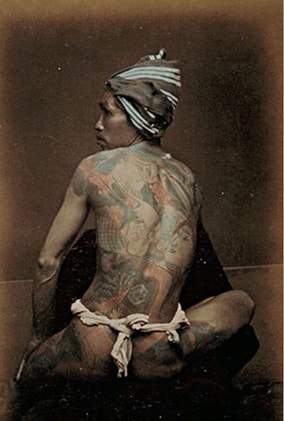
• Imagery:
The motifs are not directly meant as iconic symbols. Also realism is not done, the visual aesthetics are the first consideration. "Is it classically enjoyable to look at?”... the meaning of wearing Japanese classic tattoo is “for the arts sake"... "for the tattoo itself".... Of course there are some very iconic and very religious oriented Japanese style tattooers and patrons... and non-religious tattooers can enjoy doing religious themed tattooing as well, yet the tattoo is mostly thought of as body decoration the same as fine clothing. The classic styled Japanese tattoo in itself is generally not an iconic or religious piece of art -even if it has Buddhist elements, every item in it does not necessarily have absolute or logical meaning, it is for visual pleasure, it is decoration of the body.... but of course it should at least make sense when it is viewed, that is where the experience of the craftsman comes in. The tattooer should know what to do and what not to do in order for the client to not end up embarrassed or ashamed of the tattoo (and to not give an accidental touristy look to the tattoo). A simple example could be if the persons back has an underwater theme tattooed then it would make no sense doing birds or a Fu-lion on the legs as these images are not normally found in water etc…
In classic Japanese style -images are "not" often thought of in the same way as they are in western thought: to aid you in understanding this- western examples "could" be "eagle" vs. the "dragon"... or the "angel" vs. the "devil", the "heart" vs. the "Reaper".... or the "bulldog" vs. the "Swastika", etc, etc, etc... In western thought when mentioned these icons have absolute strong ideology behind them and they are tattooed more as opposing statements, trophies & or souvenirs than true body decoration... the western mind is usually very aware of the one point / one thought ideology, western icons have very direct statements, meanings and connotations… Souvenir tattoos are not the style of Japanese tattooing, this is “western style”. In full suit horimono the imagery will be balanced with enhancements and opposites showing a universal knowledge of “all aspects of life” yet this is subtle and not the target of classic Japanese tattoo. Full suit examples are- power balanced with humility, strength balanced with knowing weak moments, fertile sexuality balanced with clumsy giddiness & humor, rise balanced with decent etc... and in full suit tattooing to not have balance can show arrogance and a lack of understanding or knowledge, yet in limb tattooing or one point tattooing it is mostly thought of as body decor. In full body horimono imagery there is enough room (amount of skin) to show much thought- a knowledge that all aspects of life are good no matter the possible path or method we may have used, or had used on us. To obtain knowledge is the norm, to lock in on a one point statement for the rest of ones life is thought can prevent spiritual growth... but then again each patron, each person is an individual and each tattoo is therefore individual, so this is why each tattoo needs to have a knowledgeable and experienced craftsman executing it... in order for the tattooing to be done properly.
The motifs are not directly meant as iconic symbols. Also realism is not done, the visual aesthetics are the first consideration. "Is it classically enjoyable to look at?”... the meaning of wearing Japanese classic tattoo is “for the arts sake"... "for the tattoo itself".... Of course there are some very iconic and very religious oriented Japanese style tattooers and patrons... and non-religious tattooers can enjoy doing religious themed tattooing as well, yet the tattoo is mostly thought of as body decoration the same as fine clothing. The classic styled Japanese tattoo in itself is generally not an iconic or religious piece of art -even if it has Buddhist elements, every item in it does not necessarily have absolute or logical meaning, it is for visual pleasure, it is decoration of the body.... but of course it should at least make sense when it is viewed, that is where the experience of the craftsman comes in. The tattooer should know what to do and what not to do in order for the client to not end up embarrassed or ashamed of the tattoo (and to not give an accidental touristy look to the tattoo). A simple example could be if the persons back has an underwater theme tattooed then it would make no sense doing birds or a Fu-lion on the legs as these images are not normally found in water etc…
In classic Japanese style -images are "not" often thought of in the same way as they are in western thought: to aid you in understanding this- western examples "could" be "eagle" vs. the "dragon"... or the "angel" vs. the "devil", the "heart" vs. the "Reaper".... or the "bulldog" vs. the "Swastika", etc, etc, etc... In western thought when mentioned these icons have absolute strong ideology behind them and they are tattooed more as opposing statements, trophies & or souvenirs than true body decoration... the western mind is usually very aware of the one point / one thought ideology, western icons have very direct statements, meanings and connotations… Souvenir tattoos are not the style of Japanese tattooing, this is “western style”. In full suit horimono the imagery will be balanced with enhancements and opposites showing a universal knowledge of “all aspects of life” yet this is subtle and not the target of classic Japanese tattoo. Full suit examples are- power balanced with humility, strength balanced with knowing weak moments, fertile sexuality balanced with clumsy giddiness & humor, rise balanced with decent etc... and in full suit tattooing to not have balance can show arrogance and a lack of understanding or knowledge, yet in limb tattooing or one point tattooing it is mostly thought of as body decor. In full body horimono imagery there is enough room (amount of skin) to show much thought- a knowledge that all aspects of life are good no matter the possible path or method we may have used, or had used on us. To obtain knowledge is the norm, to lock in on a one point statement for the rest of ones life is thought can prevent spiritual growth... but then again each patron, each person is an individual and each tattoo is therefore individual, so this is why each tattoo needs to have a knowledgeable and experienced craftsman executing it... in order for the tattooing to be done properly.
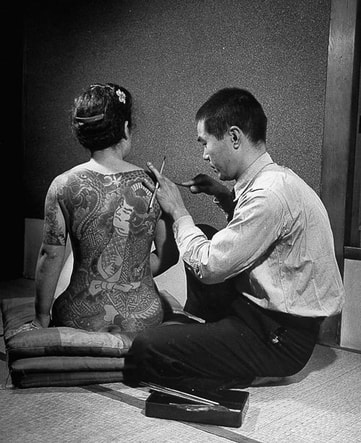
•Background imagery Vs main Imagery:
The background is traditionally restricted to one flora throughout each clients tattooing...
The flowers are the peony (botan), the chrysanthemum (kiku), the cherry blossom (sakura) and the maple leaf (the meanings are all found elsewhere on this page) the floral is commonly simple and not profoundly iconic, this is for a very strong and connected to the common people of the floating world” rather than being separated and above all, throughout one persons entire tattoo from ankle to neck. Normally not, but there are times when more than one of the flora can be shown in one tattoo; if more than one time period is being depicted in the overall art (which is not often), or simply at the firm request of the client, yet the overall tattoo is intended to be of one moment, one dream, one overall thought... From time to time I have found beauty in letting go of some of the firm tattoo theory for the final visual, thus occasionally I will mix classic flora by firm client request.
• The Back does not always need be tattooed:
If the back tattoo is not wanted, then putting powerful imagery on the arms and or legs is classic style, then they are totally appropriate. There are other classic tattoo parameters besides the back-piece and body suit! Traditionally the arm tattoo (when there is not going to be a back tattoo) can have strong themed imagery that would otherwise not be proper to frame powerful imagery on the back, meaning... when the arms are the only tattoos to be worn it is totally fine to have a strong powerful image on them, but if the back is added later it may be very difficult to find comfortable imagery to not be "strange" with existing powerful imagery (that was previously not meant as framework on the arms). This also go's for when only pants are tattooed.
• Other classic tattoo parameters besides the back-piece:
There are sleeves (as stated previously) there are short pants that are from the knees up to the hips, there are socks, there vests, there are bracelets, necklaces and shawls, there are even diagonal capes. These can be beautiful tattoos alone, the one draw-back is if there is a new decision by the patron to later continue from these. That being said it is important to give long thought before being tattooed because the suit that has been done in a backwards manner can be easily identified as awkward once completed...
The background is traditionally restricted to one flora throughout each clients tattooing...
The flowers are the peony (botan), the chrysanthemum (kiku), the cherry blossom (sakura) and the maple leaf (the meanings are all found elsewhere on this page) the floral is commonly simple and not profoundly iconic, this is for a very strong and connected to the common people of the floating world” rather than being separated and above all, throughout one persons entire tattoo from ankle to neck. Normally not, but there are times when more than one of the flora can be shown in one tattoo; if more than one time period is being depicted in the overall art (which is not often), or simply at the firm request of the client, yet the overall tattoo is intended to be of one moment, one dream, one overall thought... From time to time I have found beauty in letting go of some of the firm tattoo theory for the final visual, thus occasionally I will mix classic flora by firm client request.
• The Back does not always need be tattooed:
If the back tattoo is not wanted, then putting powerful imagery on the arms and or legs is classic style, then they are totally appropriate. There are other classic tattoo parameters besides the back-piece and body suit! Traditionally the arm tattoo (when there is not going to be a back tattoo) can have strong themed imagery that would otherwise not be proper to frame powerful imagery on the back, meaning... when the arms are the only tattoos to be worn it is totally fine to have a strong powerful image on them, but if the back is added later it may be very difficult to find comfortable imagery to not be "strange" with existing powerful imagery (that was previously not meant as framework on the arms). This also go's for when only pants are tattooed.
• Other classic tattoo parameters besides the back-piece:
There are sleeves (as stated previously) there are short pants that are from the knees up to the hips, there are socks, there vests, there are bracelets, necklaces and shawls, there are even diagonal capes. These can be beautiful tattoos alone, the one draw-back is if there is a new decision by the patron to later continue from these. That being said it is important to give long thought before being tattooed because the suit that has been done in a backwards manner can be easily identified as awkward once completed...
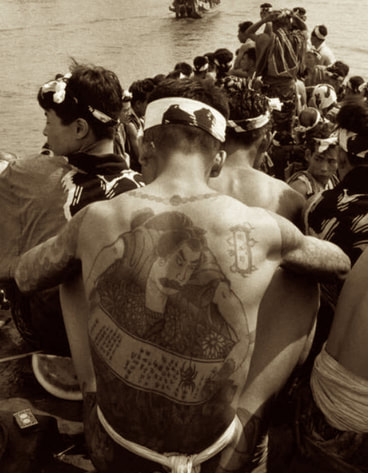
• “How”?
“Specialized” tattooers with a great knowledge and passion do true classic Edo style tattooing. For the client -being tattooed is difficult and time consuming, relatively costly and yes it is painful to collect, thus it is not for everyone. It takes dedication and a true long lasting passion for the craft. The traditional "Turtle Back" alone (Back Piece) can take more than a year of bi-weekly visits to complete. On a personal note my regular clientele are a patient and dedicated group indeed... A great thing about wearing this style is that it shows the person who is wearing it has a passion for a single style of art / craft / tattoo, it shows that they can finish what they say they can do, it shows that they can be dedicated, it shows that they can control themselves during pain. It shows that they can manage and budget their money maturely as well as showing that they have the proper patience to undergo the sometimes difficult humbling process.
• Application:
-First tattooed are the “out-lines”.
-Then the shaded areas of black and faded black are done (black & grey).
-Last is the color.
... If it is fully backgrounded tattooing -the background (black and faded black fields) is usually done first and the main imagery is colored last. If the tattoo is an animal or person, the images eyes are usually not filled in until last... the saying goes -the tattoo is brought to life when the eyes are filled in, do not bring life to a tattoo that is incomplete, it would be much too painful for it to see it's self un-finished.
After the back the framing, balancing and enhancing of it is done on the ribs, legs and arms to "frame" it.
The back asserts the design theme and the rest frames and elaborates on that. An easy way to think of the classic lay-out would most often be one image per body part for proper balance, size and scale (to fit the body nicely) it is visually most often to not be cluttered with too many images or colors. There are times when this is not followed, but in general this is the traditional way. There are only four colors used because classically it is too flashy and arrogant to put more. There are red, yellow, brown and indigo, (some mixing may be done as in orange and green) even less colors are used in some forms of classic styles. Also.... do not fill every space with an image but use the space for balance to the body’s flow and shape. Fitting the tattoo to the size, form and flow of its body part is very pleasing to the eye and there are 9 natural placements for images on the body when an entire suit is wanted.
• Zones of a full body suit (classic tattoo layout for full coverage):
Here are 9 natural placements (APPROXIMATE) for a full suit (before backgrounding is done) this is not absolute, this is not a mandatory rule, this is simply an approximate and helpful guideline, a technique that has generally worked well for the past couple hundred years (this does not mean to center and exactly size imagery to these placements, it simply is here as a helpful basic layout).
-1. One image on the back.
-2 & 3. One image each arm and chest plate (If fore-arms are to be done to the wrist they usually have the imagery from the upper arm brought down).
-4 & 5. One image each front upper leg area.
-6 & 7. One image each rib area.
-8 & 9. One image each lower leg (classically lower legs have independent imagery, but ascetics can be done differently and still be classical).
This is the general balance, yet it is not the absolute layout for all classic full body suits. On the large enough area of the back, imagery can have 2 or 3 focal points i.e. a Tiger and Snake and or a dragon, a phoenix (Hou Ou) and snake and a Flower... or a ronin vs. a serpent... Kintaro vs. giant koi or serpent etc... As long as the imagery's detail does not become so small and cluttered that it prevents the tattoo from being classic (the smaller the imagery the less time that it will be viewable due to the soft blurring that happens with all tattooing by age). Scale is very important for a tattoo to still look nice in later years.
“Specialized” tattooers with a great knowledge and passion do true classic Edo style tattooing. For the client -being tattooed is difficult and time consuming, relatively costly and yes it is painful to collect, thus it is not for everyone. It takes dedication and a true long lasting passion for the craft. The traditional "Turtle Back" alone (Back Piece) can take more than a year of bi-weekly visits to complete. On a personal note my regular clientele are a patient and dedicated group indeed... A great thing about wearing this style is that it shows the person who is wearing it has a passion for a single style of art / craft / tattoo, it shows that they can finish what they say they can do, it shows that they can be dedicated, it shows that they can control themselves during pain. It shows that they can manage and budget their money maturely as well as showing that they have the proper patience to undergo the sometimes difficult humbling process.
• Application:
-First tattooed are the “out-lines”.
-Then the shaded areas of black and faded black are done (black & grey).
-Last is the color.
... If it is fully backgrounded tattooing -the background (black and faded black fields) is usually done first and the main imagery is colored last. If the tattoo is an animal or person, the images eyes are usually not filled in until last... the saying goes -the tattoo is brought to life when the eyes are filled in, do not bring life to a tattoo that is incomplete, it would be much too painful for it to see it's self un-finished.
After the back the framing, balancing and enhancing of it is done on the ribs, legs and arms to "frame" it.
The back asserts the design theme and the rest frames and elaborates on that. An easy way to think of the classic lay-out would most often be one image per body part for proper balance, size and scale (to fit the body nicely) it is visually most often to not be cluttered with too many images or colors. There are times when this is not followed, but in general this is the traditional way. There are only four colors used because classically it is too flashy and arrogant to put more. There are red, yellow, brown and indigo, (some mixing may be done as in orange and green) even less colors are used in some forms of classic styles. Also.... do not fill every space with an image but use the space for balance to the body’s flow and shape. Fitting the tattoo to the size, form and flow of its body part is very pleasing to the eye and there are 9 natural placements for images on the body when an entire suit is wanted.
• Zones of a full body suit (classic tattoo layout for full coverage):
Here are 9 natural placements (APPROXIMATE) for a full suit (before backgrounding is done) this is not absolute, this is not a mandatory rule, this is simply an approximate and helpful guideline, a technique that has generally worked well for the past couple hundred years (this does not mean to center and exactly size imagery to these placements, it simply is here as a helpful basic layout).
-1. One image on the back.
-2 & 3. One image each arm and chest plate (If fore-arms are to be done to the wrist they usually have the imagery from the upper arm brought down).
-4 & 5. One image each front upper leg area.
-6 & 7. One image each rib area.
-8 & 9. One image each lower leg (classically lower legs have independent imagery, but ascetics can be done differently and still be classical).
This is the general balance, yet it is not the absolute layout for all classic full body suits. On the large enough area of the back, imagery can have 2 or 3 focal points i.e. a Tiger and Snake and or a dragon, a phoenix (Hou Ou) and snake and a Flower... or a ronin vs. a serpent... Kintaro vs. giant koi or serpent etc... As long as the imagery's detail does not become so small and cluttered that it prevents the tattoo from being classic (the smaller the imagery the less time that it will be viewable due to the soft blurring that happens with all tattooing by age). Scale is very important for a tattoo to still look nice in later years.
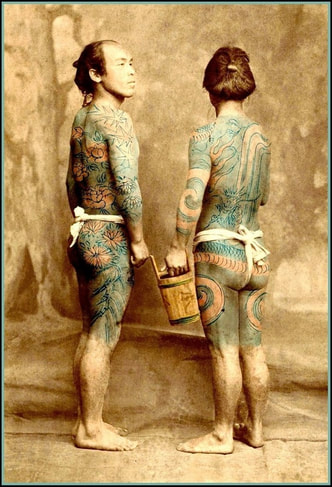 1830's - 70's Japanese tattoo. Today called- classic Japanese style, aka wabori tattoo. Photo taken aprox 1870 by
"Felice Beato"
or
"Adolfo Farsari".
1830's - 70's Japanese tattoo. Today called- classic Japanese style, aka wabori tattoo. Photo taken aprox 1870 by
"Felice Beato"
or
"Adolfo Farsari".
• Classic VS Modern:
Classic tattooing is done with a passion for this one stylized art and it has stylistically been un-changed for 200 years. The classic Japanese tattoo is emulating and very often referenced directly to Edo period art with the original 4 colors, it is for people whom want and admire this particular classic style.
I personally don’t enjoy modernizing, westernizing or changing the classic style, I enjoy the strong ties to the past. I am nostalgic.
- For clarification and example... old Aztec, Mayan, Incan, Haida, Sioux, Cherokee, Egyptian, Apache, Ute, Roman, Italian, Irish, Celtic, Chinese, Tibetan, Hindu etc... These each in their own rite are classic forms of art. Edo period Japanese art is no different, yes changing a stylization can be fun and beautiful, it simply is not enjoyable to me... nor is it classic after modern changes have been made.
To truly admire, love, enjoy and understand the style of actual classic tattooing it is important for me to know, understand and admire the works of each era in modern tattooing, but I don't have the ability to tattoo everyone that asks me to tattoo them, as I am from time to time booked way out, I only take on the work that I feel I am best matched for, this is my comfort zone and is perfect for me.
• Beginning's of Horimono:
Before the "late" Edo period the role of tattoos in Japan fluctuated, graphic styles (these days commonly called tribal), rather than pictoral imagery was the only known style of all tattooing worldwide. It was during the "late" Edo period when the Japanese ukiyo e art began to develop into a form of art that enveloped all the working class people of pre-Tokyo, this is what inspired and what became the classic Japanese tattoo, the ukiyo e art was being tattooed and that IS how the modern day "pictoral image tattoo" began. This is well documented by the west during the late 1850's, 60's, 70's & 80's. It was often stated in news articles and other forms of documents that the people of Edo were all very tattooed, first sight for the westerners would be the dock workers, men unloading the ships, first being the American and Portuguese ships that came to pressure Japan to trade, the tattoo was not presented as anything but normal. This is one of the reasons that eventually Japan fervently pursued conviction of tattooers- because many of the westerners were sometimes seeing the tattooing as shocking, crude & un-evolved tribal behavior (typical persecution and arrogant opinions by bigoted "know-it-all's" if you ask me).
A great example of how normal the tattooing was back in the day are the ukiyo e of the firemen of the time, they were the living hero's of that specific time. The designs of the popular ukiyo e firemen series published from 1835 to 1899 were often illustrated in shisei displaying past and present hero’s / ronin / vigilantes / samurai... most being very heavily tattooed themselves, wearing horimono today can be an aspiration to these shisei qualities. Much Edo period art and ukiyo e still exists today of these men, these "Cool Cats" of they're day, firemen were popular living figures of bravery, vigilante and sex-appeal, they wore tattoos both as a form of body decoration and as spiritual aid / protection. Of the many genre one popular example for firemen is the dragon, of firemen tattoos the most dominant is the "suit of 9 dragons" (a full body suit, wrist to ankle, having nine dragons), it was worn by a lot of firemen to give them the same power that dragons have over wind, fire and water. A seven dragon suit is just as strong as a 9 dragon suit, it simply has omitted the lower leg dragons, the 7 dragon suit has a 1/2 to 3/4 length pant leg and 1/2 to 3/4 length sleeves, the rest of the body is the same coverage as the 9. Evidence shows it was quite normal for the merchants, the fishermen, ladies, geisha, wives, carpenters, construction workers, firemen, dock workers, field workers... fact is that all levels of everyday society were tattooed.... that is until Japanese government began stopping the tattoo from being a normal part of Edo life. Making a good impression on the west became so important to the Japanese government that in the 1860's and 70's tattooing was something that some westerners could "possibly" consider tribal and un-civilized, thus creating a pressure to find and prosecute the tattooers in order to remove tattooing from normal day life in Edo, paradox is that the Japanese tattoo soon became wanted by the rest of the world to show how traveled and worldly a person was...
Tattooing was again legalized in Japan by the western occupation forces in 1945, but sadly it has still retained an image of criminality. Japanese tattoos are often associated with the yakuza, Japan’s mafia, and many businesses in Japan such as public beaches, baths, and fitness centers, hot springs still to this day "ban" people that have visible tattoos. The true majority of collectors of tattoo are not mafia -but are people who love Japans past, Japanese art and it's tradition, they are generally people that do not want the traditions of old Japan to disappear or be lost in today's westernized world. There are as many reasons to wear the tattoo as there are people. It could literally and simply be that tattooing is the way to decorate ones temple. No matter the reason it is beginning to once again be admired as a great skilled craft with depth that no other can achieve.
Classic tattooing is done with a passion for this one stylized art and it has stylistically been un-changed for 200 years. The classic Japanese tattoo is emulating and very often referenced directly to Edo period art with the original 4 colors, it is for people whom want and admire this particular classic style.
I personally don’t enjoy modernizing, westernizing or changing the classic style, I enjoy the strong ties to the past. I am nostalgic.
- For clarification and example... old Aztec, Mayan, Incan, Haida, Sioux, Cherokee, Egyptian, Apache, Ute, Roman, Italian, Irish, Celtic, Chinese, Tibetan, Hindu etc... These each in their own rite are classic forms of art. Edo period Japanese art is no different, yes changing a stylization can be fun and beautiful, it simply is not enjoyable to me... nor is it classic after modern changes have been made.
To truly admire, love, enjoy and understand the style of actual classic tattooing it is important for me to know, understand and admire the works of each era in modern tattooing, but I don't have the ability to tattoo everyone that asks me to tattoo them, as I am from time to time booked way out, I only take on the work that I feel I am best matched for, this is my comfort zone and is perfect for me.
• Beginning's of Horimono:
Before the "late" Edo period the role of tattoos in Japan fluctuated, graphic styles (these days commonly called tribal), rather than pictoral imagery was the only known style of all tattooing worldwide. It was during the "late" Edo period when the Japanese ukiyo e art began to develop into a form of art that enveloped all the working class people of pre-Tokyo, this is what inspired and what became the classic Japanese tattoo, the ukiyo e art was being tattooed and that IS how the modern day "pictoral image tattoo" began. This is well documented by the west during the late 1850's, 60's, 70's & 80's. It was often stated in news articles and other forms of documents that the people of Edo were all very tattooed, first sight for the westerners would be the dock workers, men unloading the ships, first being the American and Portuguese ships that came to pressure Japan to trade, the tattoo was not presented as anything but normal. This is one of the reasons that eventually Japan fervently pursued conviction of tattooers- because many of the westerners were sometimes seeing the tattooing as shocking, crude & un-evolved tribal behavior (typical persecution and arrogant opinions by bigoted "know-it-all's" if you ask me).
A great example of how normal the tattooing was back in the day are the ukiyo e of the firemen of the time, they were the living hero's of that specific time. The designs of the popular ukiyo e firemen series published from 1835 to 1899 were often illustrated in shisei displaying past and present hero’s / ronin / vigilantes / samurai... most being very heavily tattooed themselves, wearing horimono today can be an aspiration to these shisei qualities. Much Edo period art and ukiyo e still exists today of these men, these "Cool Cats" of they're day, firemen were popular living figures of bravery, vigilante and sex-appeal, they wore tattoos both as a form of body decoration and as spiritual aid / protection. Of the many genre one popular example for firemen is the dragon, of firemen tattoos the most dominant is the "suit of 9 dragons" (a full body suit, wrist to ankle, having nine dragons), it was worn by a lot of firemen to give them the same power that dragons have over wind, fire and water. A seven dragon suit is just as strong as a 9 dragon suit, it simply has omitted the lower leg dragons, the 7 dragon suit has a 1/2 to 3/4 length pant leg and 1/2 to 3/4 length sleeves, the rest of the body is the same coverage as the 9. Evidence shows it was quite normal for the merchants, the fishermen, ladies, geisha, wives, carpenters, construction workers, firemen, dock workers, field workers... fact is that all levels of everyday society were tattooed.... that is until Japanese government began stopping the tattoo from being a normal part of Edo life. Making a good impression on the west became so important to the Japanese government that in the 1860's and 70's tattooing was something that some westerners could "possibly" consider tribal and un-civilized, thus creating a pressure to find and prosecute the tattooers in order to remove tattooing from normal day life in Edo, paradox is that the Japanese tattoo soon became wanted by the rest of the world to show how traveled and worldly a person was...
Tattooing was again legalized in Japan by the western occupation forces in 1945, but sadly it has still retained an image of criminality. Japanese tattoos are often associated with the yakuza, Japan’s mafia, and many businesses in Japan such as public beaches, baths, and fitness centers, hot springs still to this day "ban" people that have visible tattoos. The true majority of collectors of tattoo are not mafia -but are people who love Japans past, Japanese art and it's tradition, they are generally people that do not want the traditions of old Japan to disappear or be lost in today's westernized world. There are as many reasons to wear the tattoo as there are people. It could literally and simply be that tattooing is the way to decorate ones temple. No matter the reason it is beginning to once again be admired as a great skilled craft with depth that no other can achieve.
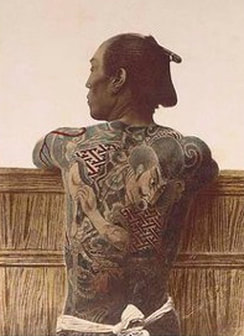
WESTERN TERMS ~
-Suit: Tattoo from neck down to the thighs or ankles. May have full sleeves, three quarter sleeves half sleeves or no sleeve.
-Backpiece: Tattoo on the back, from mid thigh up to the collar line at the neck, classically called a turtle back.
-Pants: Tattoo on the legs, Short pants or long pants or a pant leg are the right terms- this is wrongly called "leg-sleeves" as if it were a shirt. Tattoos are worn as clothing. Different lengths are ended above the knee (depending on body shape) but once extended below the knee it traditionally MUST be continued until the ankles.
-Jacket: Tattoo on the back, ribs and arms.
-Sleeve: Tattoo on the arms. There are full sleeves, three quarter sleeves and half sleeves just like on a shirt. These tattoos are worn from the top down - from the collar bone down to just above the wrist, mid fore-arm or just above the ditch (inside elbow bend).
-Socks: Tattoo below the knee to the ankle, it is also traditional to put a tattoo on the top of the foot.
-Bracelet, Anklet, Necklace: Tattoo at the parameter or edging of a suit as a "hem-line".
JAPANESE TERMS ~
-Ukiyo e: "Ukiyo e" is the woodblock artwork print, in standard size ("ew key yo ee", it is approximately 5 fists high by 3 & 1/2 fists wide (the most used, most common size is called - Oban size).
-Horimono: Specifically describes the classic Japanese style of tattoo, imagery on each person all within one thought - decoratively placed on the body, often tattooed like clothing. Hori means master carver or carved, mono means one, one idea, one picture.
-Wabori: Means "in the old style" or in the "classic" style. Wabori is a word that represents the opposite of modern (this word is used to describe skills done in the old style. It could be cooking, it could be drawing, sculpting, decorating etc...).
-Irezumi: Means tattoo, it is not-specific to any one style - it does not mean horimono. Irezumi is the term for any style of tattooing. Any permanent mark in the skin with ink is irezumi. it simply means tattoo, "any" tattoo.
-Nukibori: Floating the tattoo imagery on the body yet not connecting them with background. It is a normal classic style to do no backgrounding.
-Kamenokogakubori: “Also called the "turtle-shell". if no backgrounding is done then it is a “Nukibori back”. Kamenokogakubori is where the subject and background all occupy only the back (including the buttocks and the thighs). Traditionally only the tattooer that applied the Kamenokogakubori is allowed to sign the tattoo (the signature is called a "chop"), traditionally he is the tattooer to do the other parts of the body as well but only the back is signed.
-Munewari: A suit having a short-sleeved jacket and short pants yet with un-tattooed skin in the front torso - called the river. The river is generally sized by using the measurement of the clients own fist. A side fist width measured for mid chest (over the heart) and a flat fist width at belly button continued to the thighs (this is not absolute, just a general rule).
-Sooushinbori: is the full body suit with no opening on the front torso, and it is from collar to ankles, the arms may be short, mid length or long.
-Kantobori & Kansabori: Chest plates are done in two types... The "Kantobori" is the usual, it does not reach the bottom of the pectoral muscle and does not cover the nipple area, it is done from approximately one half inch above the nipple up. The collar is approximately the same above the collarbone as a normal t-shirt height. And has a flat fist width space between. The second kind of chest plate is called "Kansabori", it does include the nipple area and covers the entire chest muscle. The Kansabori should only be done by experienced tattooers - as it can look a bit like a colorful female bra if not done just right. It depends on the body wearing it as to how much un-tattooed skin is left between each chest plate, a side fist or a flat fist.
-Shichibu: (most common sleeve length) Traditionaly the arm is scaled by tenths. the halway point is called 5/10 (five tenths) center - at the elbow / ditch area. but the standard is the 7/10 (seven tenths) sleeves; it is called "Shichibu".
-Suit: Tattoo from neck down to the thighs or ankles. May have full sleeves, three quarter sleeves half sleeves or no sleeve.
-Backpiece: Tattoo on the back, from mid thigh up to the collar line at the neck, classically called a turtle back.
-Pants: Tattoo on the legs, Short pants or long pants or a pant leg are the right terms- this is wrongly called "leg-sleeves" as if it were a shirt. Tattoos are worn as clothing. Different lengths are ended above the knee (depending on body shape) but once extended below the knee it traditionally MUST be continued until the ankles.
-Jacket: Tattoo on the back, ribs and arms.
-Sleeve: Tattoo on the arms. There are full sleeves, three quarter sleeves and half sleeves just like on a shirt. These tattoos are worn from the top down - from the collar bone down to just above the wrist, mid fore-arm or just above the ditch (inside elbow bend).
-Socks: Tattoo below the knee to the ankle, it is also traditional to put a tattoo on the top of the foot.
-Bracelet, Anklet, Necklace: Tattoo at the parameter or edging of a suit as a "hem-line".
JAPANESE TERMS ~
-Ukiyo e: "Ukiyo e" is the woodblock artwork print, in standard size ("ew key yo ee", it is approximately 5 fists high by 3 & 1/2 fists wide (the most used, most common size is called - Oban size).
-Horimono: Specifically describes the classic Japanese style of tattoo, imagery on each person all within one thought - decoratively placed on the body, often tattooed like clothing. Hori means master carver or carved, mono means one, one idea, one picture.
-Wabori: Means "in the old style" or in the "classic" style. Wabori is a word that represents the opposite of modern (this word is used to describe skills done in the old style. It could be cooking, it could be drawing, sculpting, decorating etc...).
-Irezumi: Means tattoo, it is not-specific to any one style - it does not mean horimono. Irezumi is the term for any style of tattooing. Any permanent mark in the skin with ink is irezumi. it simply means tattoo, "any" tattoo.
-Nukibori: Floating the tattoo imagery on the body yet not connecting them with background. It is a normal classic style to do no backgrounding.
-Kamenokogakubori: “Also called the "turtle-shell". if no backgrounding is done then it is a “Nukibori back”. Kamenokogakubori is where the subject and background all occupy only the back (including the buttocks and the thighs). Traditionally only the tattooer that applied the Kamenokogakubori is allowed to sign the tattoo (the signature is called a "chop"), traditionally he is the tattooer to do the other parts of the body as well but only the back is signed.
-Munewari: A suit having a short-sleeved jacket and short pants yet with un-tattooed skin in the front torso - called the river. The river is generally sized by using the measurement of the clients own fist. A side fist width measured for mid chest (over the heart) and a flat fist width at belly button continued to the thighs (this is not absolute, just a general rule).
-Sooushinbori: is the full body suit with no opening on the front torso, and it is from collar to ankles, the arms may be short, mid length or long.
-Kantobori & Kansabori: Chest plates are done in two types... The "Kantobori" is the usual, it does not reach the bottom of the pectoral muscle and does not cover the nipple area, it is done from approximately one half inch above the nipple up. The collar is approximately the same above the collarbone as a normal t-shirt height. And has a flat fist width space between. The second kind of chest plate is called "Kansabori", it does include the nipple area and covers the entire chest muscle. The Kansabori should only be done by experienced tattooers - as it can look a bit like a colorful female bra if not done just right. It depends on the body wearing it as to how much un-tattooed skin is left between each chest plate, a side fist or a flat fist.
-Shichibu: (most common sleeve length) Traditionaly the arm is scaled by tenths. the halway point is called 5/10 (five tenths) center - at the elbow / ditch area. but the standard is the 7/10 (seven tenths) sleeves; it is called "Shichibu".
• How Mistakes Happen:
Now I put this out there to "hopefully help" before the tattoo is requested -be careful not to ask for imagery that clashes in "over-all" structure, at that point a tattooer only has a few choices... these choices are to spend time (possibly hours) explaining to the client what they are backwardly asking for, or another choice is to go ahead and do the requested tattooing because that’s what the client wants, or respectfully refer that they find another tattooer that will better fit they're wants..... Those really are the tattooers’ only choices.
If it does, or will, matter to you that your tattoo be true to it's classic tradition -then it is important to at the least know a little bit about what is being asked for before you ask for it. Possible important things for you to know: know this style is based on stylized Edo period Japanese art, know a bit about the image genre that you want tattooed and know if you really do want it expertly and knowledgeably tattooed on you.
Wanting "true classic" style of tattooing and not having a specific image in mind is ok, the tattooer can help you with that as long as you are able to let him or her guide your choice, but it is beneficial to at the least have a "genre, image or theme" in mind as one genre (type of story or theme) is used throughout the tattoo.
Now I put this out there to "hopefully help" before the tattoo is requested -be careful not to ask for imagery that clashes in "over-all" structure, at that point a tattooer only has a few choices... these choices are to spend time (possibly hours) explaining to the client what they are backwardly asking for, or another choice is to go ahead and do the requested tattooing because that’s what the client wants, or respectfully refer that they find another tattooer that will better fit they're wants..... Those really are the tattooers’ only choices.
If it does, or will, matter to you that your tattoo be true to it's classic tradition -then it is important to at the least know a little bit about what is being asked for before you ask for it. Possible important things for you to know: know this style is based on stylized Edo period Japanese art, know a bit about the image genre that you want tattooed and know if you really do want it expertly and knowledgeably tattooed on you.
Wanting "true classic" style of tattooing and not having a specific image in mind is ok, the tattooer can help you with that as long as you are able to let him or her guide your choice, but it is beneficial to at the least have a "genre, image or theme" in mind as one genre (type of story or theme) is used throughout the tattoo.
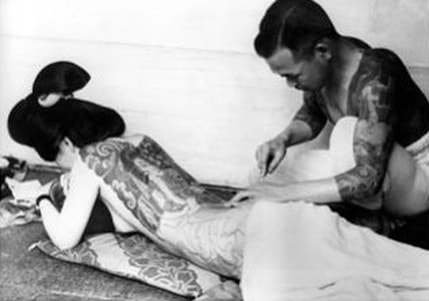
• Process:
In general choosing the main theme, the first image (traditionally the "Turtle Back") is up to the client, and then the rest of the tattoo framework / layout / arms /legs / ribs and background is done by the tattooer in order to balance that main image. In general (but not always) the lower part of the body is water, the middle part of the body is water transitioning to earth. The upper part of the body is earth transitioning to wind. If the main design is water or earth then the visual balance is then shifted to suit the genre / theme accordingly. But it does not ever make sense to put imagery like koi above a flying dragon or Fu-lion... The emphasis is on the main imageries setting.
I have learned that many clients here in the states want to start on the arm or leg, with a 1/4 or a 1/2 sleeve or sometimes even a sock. I try to look visionally ahead as much as I can in this situation -yet clash of imagery can occur by the client being tattooed backwards from the outside-in. Horimono fits the body much differently than western souvenir tattooing. Japanese tattooing can be "very profound" when properly executed, it is specifically meant to decorate the body on a whole. To be honest tattooing the "arms first" is random and backwards, as in painting the outside edges and corners of a painting before even thinking about the center of it. It's OK-- it is what it is and I enjoy it. I do my best with what each client asks me to do, I am happy to do it, and I am grateful for it.
In general choosing the main theme, the first image (traditionally the "Turtle Back") is up to the client, and then the rest of the tattoo framework / layout / arms /legs / ribs and background is done by the tattooer in order to balance that main image. In general (but not always) the lower part of the body is water, the middle part of the body is water transitioning to earth. The upper part of the body is earth transitioning to wind. If the main design is water or earth then the visual balance is then shifted to suit the genre / theme accordingly. But it does not ever make sense to put imagery like koi above a flying dragon or Fu-lion... The emphasis is on the main imageries setting.
I have learned that many clients here in the states want to start on the arm or leg, with a 1/4 or a 1/2 sleeve or sometimes even a sock. I try to look visionally ahead as much as I can in this situation -yet clash of imagery can occur by the client being tattooed backwards from the outside-in. Horimono fits the body much differently than western souvenir tattooing. Japanese tattooing can be "very profound" when properly executed, it is specifically meant to decorate the body on a whole. To be honest tattooing the "arms first" is random and backwards, as in painting the outside edges and corners of a painting before even thinking about the center of it. It's OK-- it is what it is and I enjoy it. I do my best with what each client asks me to do, I am happy to do it, and I am grateful for it.
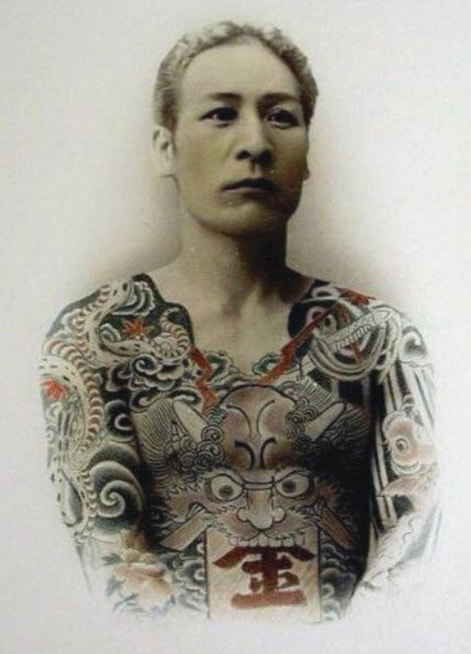
As far as my tattooing - classic Japanese style tattoo is what I specialize in, though I will take-on an occasional request for different themes as long as i feel that i am the right craftsman for the job.
Horimono has been unchanged for 200 years, it is the origin of the modern day picture tattoo. The Japanese tattoo is timeless, it ages well & it's not quirky, quick or gimmicky... nor does it have the "knick-knack collection" randomness that western tattooing has become. To me it's great that so many of today’s tattoo admirers are embracing it. It's always waiting for new admirers, never went away, it’s been continuous... its been worn on each new generation since its beginning.
Enjoying the mid 1800's Edo era Japanese "art" is all that is needed to wear this style of tattoo.
• Why think before you ink:
Some individuals can be surprised by the time consuming process of horimono tattooing... if you are possibly in a rush to have it done or simply want it done smaller- this style of tattooing is not for you.
Also if Edo era art is not what you enjoy looking at... it really doesn't make sense to have it tattooed on you for the rest of your life. Most respectfully, I recommend that you find the right tattooer, one that is doing exactly the style and size tattooing that you are interested in.
Horimono has been unchanged for 200 years, it is the origin of the modern day picture tattoo. The Japanese tattoo is timeless, it ages well & it's not quirky, quick or gimmicky... nor does it have the "knick-knack collection" randomness that western tattooing has become. To me it's great that so many of today’s tattoo admirers are embracing it. It's always waiting for new admirers, never went away, it’s been continuous... its been worn on each new generation since its beginning.
Enjoying the mid 1800's Edo era Japanese "art" is all that is needed to wear this style of tattoo.
• Why think before you ink:
Some individuals can be surprised by the time consuming process of horimono tattooing... if you are possibly in a rush to have it done or simply want it done smaller- this style of tattooing is not for you.
Also if Edo era art is not what you enjoy looking at... it really doesn't make sense to have it tattooed on you for the rest of your life. Most respectfully, I recommend that you find the right tattooer, one that is doing exactly the style and size tattooing that you are interested in.
———————————————--
www.ClarkNorthArt.com
———————————————--
www.ClarkNorthArt.com
———————————————--
A&E Tattoo TV Show "INKED" 2004-2006
INTERVIEW VIMEO VIDEO
ARTS VISUALS VIMEO VIDEO
Social Networks
Facebook.com/Clark.North
Instagram @ClarkNorthTattoo
Tumblr @ClarkNorthFineArts
Black Market Art Company
Twitter
Find the contact page on this web-site... please don't use facebook, twitter, tumbler or instagram for booking appointments or messages.
INTERVIEW VIMEO VIDEO
ARTS VISUALS VIMEO VIDEO
Social Networks
Facebook.com/Clark.North
Instagram @ClarkNorthTattoo
Tumblr @ClarkNorthFineArts
Black Market Art Company
Find the contact page on this web-site... please don't use facebook, twitter, tumbler or instagram for booking appointments or messages.
